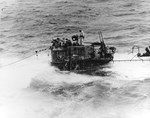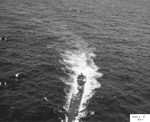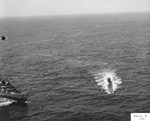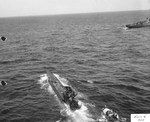U-505
| Country | Germany |
| Ship Class | Type IX-class Submarine |
| Builder | Deutsche Werft Hamburg |
| Yard Number | 295 |
| Laid Down | 12 Jun 1940 |
| Launched | 24 May 1941 |
| Commissioned | 26 Aug 1941 |
| Displacement | 1,120 tons standard; 1,232 tons submerged |
| Length | 252 feet |
| Beam | 22 feet |
| Draft | 15 feet |
| Machinery | Two MAN M9V40/46 supercharged 9-cyl diesel engines rated at 4,400hp; two SSW GU345/34 double-acting electric motors rated at 1,000hp each |
| Speed | 18 knots |
| Crew | 48 |
| Armament | 4x55cm bow torpedo tubes, 2x55cm stern torpedo tubes, 22 torpedoes, 1x105mm SK C/32 deck gun, 1x3.7 cm (1.5in) SK C/30, 2x2cm (0.79in) C/30 anti-aircraft gun |
| Submerged Speed | 7.3 knots |
| Captured by US Navy | 4 Jun 1944 |
Contributor: David Stubblebine
ww2dbaseThe U-505 was a German Type IX-C class submarine. Her keel was laid on 12 Jun 1940 at Deutsche Werft in Hamburg, Germany. She was launched on 25 May 1941 and commissioned on 26 Aug 1941 with Kapitänleutnant Axel-Olaf Loewe in command. U-505 conducted 12 patrols in her career, sinking eight merchant ships totaling 46,447 tons.
ww2dbaseOn 19 Jan 1942, U-505 sailed from Kiel, Germany for her first patrol while still formally undergoing training. During the 16 days of this patrol, she circumnavigated the British Isles before docking at Lorient in occupied France on 3 Feb 1942. She engaged no enemy vessels and was not attacked.
ww2dbaseU-505 left Lorient on 11 Feb 1942 on her second patrol. In 86 days, she traveled to the west coast of Africa where she sank four ships. On 18 Apr 1942, U-505 was attacked by an Allied aircraft in the mid-Atlantic but suffered little damage.
ww2dbaseU-505 began her third patrol from Lorient on 7 Jun 1942 bound for in the Caribbean Sea. She sank three ships on this patrol including the Colombian sailing vessel Urious. Urious belonged to a Colombian diplomat and became Colombia's political grounds to declare war on Germany. U-505 returned to Lorient on 25 Aug 1942 after 80 days on patrol without being attacked. On 6 Sep 1942, Kapitänleutnant Loewe was relieved and Kapitänleutnant Peter Zschech took command.
ww2dbaseU-505's fourth patrol began on 4 Oct 1942 and sent her to the northern coast of South America. She sank a British freighter off the Venezuelan coast on 7 Nov 1942 near Trinidad. Three days later, U-505 was surprised on the surface by a Lockheed Hudson maritime patrol aircraft from the Royal Air Force No. 53 Squadron. During the low-level attack, a 250-pound bomb hit directly on the deck just above the water line. The explosion killed one watch officer and wounded another in the conning tower. It also tore the anti-aircraft gun off its mounting and severely damaged the ship's pressure hull. The aircraft was hit by fragments from its own exploding bomb and crashed into the ocean near the submarine, killing RAAF pilot Flight Sergeant Ronald Sillcock and his entire crew. With the pumps inoperative and water flooding the engine room in several places, Kapitänleutnant Zschech ordered the crew to abandon ship, but the technical staff, led by Chief Petty Officer Otto Fricke, insisted on trying to save her. The vessel was made water-tight after almost two weeks of repair work. After transferring the wounded watch officer to the supply submarine U-462, U-505 limped back to Lorient on reduced power, earning the distinction of being the "most heavily damaged U-boat to successfully return to port."
ww2dbaseAfter six months in Lorient for repairs, U-505 started her fifth patrol on 1 Jul 1943. She returned 13 days later after an attack by three British destroyers that had stalked her for over 30 hours. Even though U-505 was not badly damaged in this encounter, it was still enough that she had to return to France for repairs. U-505's next four patrols were each aborted after only a few days at sea, due to equipment failure and sabotage by French dockworkers.
ww2dbaseAfter ten months in Lorient, U-505 departed for her tenth Atlantic patrol seeking to break her run of bad luck and bad morale. British destroyers spotted her east of the Azores on 24 Oct 1943 not long after crossing the Bay of Biscay. She was forced to submerge and endure a severe depth-charge attack. During the height of the attack, commanding officer Kapitänleutnant Zschech shot himself in the submarine's control room in front of his crew. First watch officer Oberleutnant zur See Paul Meyer took command and returned the boat to port with minimal damage. Zschech is believed to be the only submariner to commit suicide from the stress of a prolonged depth charging.
ww2dbaseBack at Lorient, command of U-505 was given to Oberleutnant zur See Harald Lange. U-505's eleventh patrol began on Christmas Day 1943 as part of wolfpack "Hela". She again returned early to Lorient on 2 Jan 1944, after rescuing thirty-three crew members from the German torpedo boat T25 sunk 28 Dec 1943 by British cruisers in the Bay of Biscay.
ww2dbaseThe Allies learned from decrypted German messages that U-boats were operating near the Cape Verde islands off the coast of Africa, but not their exact locations. The US Navy dispatched a "Hunter-Killer" Task Group to the area commanded by Captain Daniel V. Gallery. The group consisted of escort carrier USS Guadalcanal and destroyer escorts USS Pillsbury, USS Pope, USS Flaherty, USS Chatelain, and USS Jenks. The group sailed from Norfolk, Virginia, United States on 15 May 1944 and began searching for U-boats with high-frequency direction-finding fixes ("Huff-Duff") and air and surface reconnaissance.
ww2dbaseOn 4 Jun 1944 about 150 miles off French Morocco, USS Chatelain made sonar contact with U-505. The escorts immediately moved towards the contact while Guadalcanal launched aircraft. Depth charges brought U-505 to the surface less than seven minutes after Chatelain's first attack began. Chatelain and the other ships immediately opened fire on the submarine.
ww2dbaseLange believed U-505 to be seriously damaged and ordered his crew to abandon ship. They tried to scuttle the boat by opening sea valves as they hurriedly left the boat. Chatelain and Jenks picked up survivors while an eight-man boarding party from Pillsbury came alongside and entered through the conning tower. Led by Lieutenant (jg) Albert David, they found the body of Signalman First Class Gottfried Fischer on the deck, the only fatality of the combat. U-505 was otherwise deserted. They secured charts and codebooks, closed scuttling valves, and disarmed demolition charges. They stopped the water from coming in and they stopped her engines. The submarine remained afloat, although it was low in the water and down by the stern.
ww2dbasePillsbury attempted to take the submarine in tow but had difficulties. Guadalcanal rigged a towline from the carrier and took the U-boat in tow while Guadalcanal's chief engineer, Commander Earl Trosino, joined the salvage party. He disconnected the submarine's diesels from her electric driving motors while leaving them clutched to the propeller shafts. With the U-boat moving under tow, the propellers turned as they passed through the water, thus turning the electric drive motors. This resulted in the motors acting as generators charging the submarine's batteries. With power from the batteries, U-505's pumps cleared out the water and her air compressors blew out the ballast tanks, bringing the sub up to full surface trim.
ww2dbaseAfter three days of towing, Guadalcanal transferred U-505's tow line to the fleet tug USS Abnaki. On 19 Jun 1944, the submarine entered Port Royal Bay, Bermuda, after a tow of 1,960 miles.
ww2dbaseThe cipher materials captured from U-505 included an Enigma machine and several code books previously unknown to Allied codebreakers, including the Enigma settings for Jun 1944. The material arrived at Bletchley Park on 20 Jun 1944 allowing the Allies to break most of the remaining Enigma settings. Much of the material was only valid until the end of June so their value had some limitations. A more lasting benefit of U-505's capture came from two in-tact G7es (Zaunkönig T-5) acoustic homing torpedoes. These were thoroughly analyzed and then tested on the range, giving valuable information to the Allies.
ww2dbaseThe US Navy kept U-505 at the navy base in Bermuda and Navy intelligence officers and engineers studied it intensively. To maintain the illusion that she had been sunk rather than captured, she was painted to look like a US submarine and renamed as the USS Nemo.
ww2dbaseThe US Navy took 58 prisoners from U-505, three of them wounded. From the moment of their capture, the submarine's crew was isolated from other prisoners of war and the Red Cross was denied access to them. For the rest of the war, the crew was interned in complete secrecy near Ruston, Louisiana, United States. The Kriegsmarine ultimately declared the crew dead and informed the families to that effect. The crew was not returned to Germany until 1947.
ww2dbaseLieutenant (jg) Albert David received the Medal of Honor for leading the boarding party, the only instance in World War II the Navy awarded the Medal of Honor for actions in the Atlantic. Other boarding party members received the Navy Cross, the Silver Star, and the Legion of Merit. Captain Gallery, who conceived and executed the operation, received the Navy Distinguished Service Medal and the entire Task Group was awarded the Presidential Unit Citation.
ww2dbaseAt the end of the war in Europe, the U-505 went on a War Bond tour to New York City, Philadelphia, and Baltimore. Captain Gallery was present when the tour came to Washington, D.C. Once the war was over, the Navy had no more use for U-505. Experts had already thoroughly examined her in Bermuda and so she lay derelict at the Portsmouth Navy Yard in New Hampshire. The Navy decided to use her as a gunnery and torpedo target in 1946 but Rear Admiral Gallery saved the boat once again. Along with his brother, a Roman Catholic priest in Chicago, they arranged with the Chicago's Museum of Science and Industry to take the boat. The US government donated the submarine to the museum in Sep 1954 and the boat was towed through the Great Lakes to Chicago. The museum dedicated the submarine on 25 Sep 1954 as a permanent exhibit and a war memorial to all the sailors who lost their lives in the first and second Battles of the Atlantic.
ww2dbaseBy the time she went to the museum, nearly every removable part of the submarine had been stripped. The museum director contacted the German manufacturers who supplied the boat's original components asking for replacement parts. Every company supplied the requested parts without charge and most included letters to the effect that they wanted the boat to be a credit to German technology.
ww2dbaseU-505 Scoreboard
| Date | Name | Type | Nationality | Tonnage | Fate |
| 5 Mar 1942 | Benmohr | Cargo Ship | United Kingdom | 5,920 | Sunk |
| 6 Mar 1942 | Sydhav | Tanker | Norway | 7,597 | Sunk |
| 3 Apr 1942 | West Irmo | Cargo Ship | United States | 5,775 | Sunk |
| 4 Apr 1942 | Alphacca | Cargo Ship | Netherlands | 7,191 | Sunk |
| 28 Jun 1942 | Sea Thrush | Cargo Ship | United States | 5,447 | Sunk |
| 29 Jun 1942 | Thomas McKean | Liberty Cargo Ship | United States | 7,191 | Sunk |
| 22 Jul 1942 | Urious | 3-Masted Schooner | Colombia | 153 | Sunk |
| 7 Nov 1942 | Ocean Justice | Cargo Ship | United Kingdom | 7,173 | Sunk |
ww2dbaseSources:
Wikipedia
U-Boat.net
U-Boat Archive
Last Major Revision: Jul 2019
Submarine U-505 Interactive Map
Photographs
 |  |  |  |
U-505 Operational Timeline
| 12 Jun 1940 | German Type IXC U-Boat U-505 was laid down at Deutsche Werft in Hamburg, Germany. |
| 25 May 1941 | German Type IXC U-Boat U-505 was launched down at Deutsche Werft in Hamburg, Germany. |
| 26 Aug 1941 | German Type IXC U-Boat U-505 was a commissioned at Hamburg, Germany with Kapitänleutnant Axel-Olaf Loewe in command. |
| 19 Jan 1942 | German Type IXC U-Boat U-505 departed Kiel, Germany on her first patrol. |
| 3 Feb 1942 | German Type IXC U-Boat U-505 arrived in Lorient, France after her first patrol where she circumnavigated the British Isles while engaging no ships and was subjected to no attacks. |
| 11 Feb 1942 | German Type IXC U-Boat U-505 departed Lorient, France on her second patrol. |
| 5 Mar 1942 | German Type IXC U-Boat U-505 torpedoed and sunk the British freighter Benmohr off British West Africa (Sierra Leone). All 56 men abaord were rescued. |
| 6 Mar 1942 | German Type IXC U-Boat U-505 torpedoed and sunk the Norwegian tanker Sydhav off British West Africa (Sierra Leone). 12 were killed and 24 were rescued. |
| 3 Apr 1942 | German Type IXC U-Boat U-505 torpedoed and sunk the American freighter West Irmo off the British Gold Coast (Ghana). 10 were killed and 99 were rescued. |
| 4 Apr 1942 | German Type IXC U-Boat U-505 torpedoed and sunk the Dutch freighter Alphacca off the French Ivory Coast (Côte d'Ivoire). 15 were killed and 52 were rescued. |
| 18 Apr 1942 | German Type IXC U-Boat U-505 was attacked by an Allied aircraft in the mid-Atlantic but suffered little damage. |
| 7 Jun 1942 | German Type IXC U-Boat U-505 departed Lorient, France on her third patrol to the Caribbean Sea. |
| 28 Jun 1942 | German Type IXC U-Boat U-505 torpedoed and sunk the American freighter Sea Thrush northeast of Puerto Rico. All 66 men on board were rescued. |
| 29 Jun 1942 | German Type IXC U-Boat U-505 torpedoed and sunk the American Liberty ship Thomas McKean northeast of Puerto Rico. 5 were killed and 55 were rescued. |
| 22 Jul 1942 | German Type IXC U-Boat U-505 shelled and sunk the Columbian 3-masted schooner Urious in the Caribbean off the coast of Nicaragua. 13 were killed and the number of survivors, if any, is not known. This vessel was owned by a Columbian diplomat and its sinking was the political grounds Columbia used to declare war on Germany. |
| 25 Aug 1942 | German Type IXC U-Boat U-505 arrived at Lorient, France after her third patrol. |
| 6 Sep 1942 | Kapitänleutnant Loewe was relieved of command of the German Type IXC U-Boat U-505 in Lorient, France and Kapitänleutnant Peter Zschech took command. |
| 4 Oct 1942 | German Type IXC U-Boat U-505 departed at Lorient, France on her fourth patrol to the northern coast of South America. |
| 7 Nov 1942 | German Type IXC U-Boat U-505 torpedoed and sunk the British freighter Ocean Justice off the coast of Trinidad. All 56 men aboard survived. |
| 10 Nov 1942 | German Type IXC U-Boat U-505 was surprised on the surface by a Lockheed Hudson maritime patrol bomber from the Royal Air Force No. 53 Squadron. During the low-level attack off the coast of Trinidad, a 250 lb. bomb hit directly on the deck from just above the water line. The explosion killed one watch officer and wounded another in the conning tower. It also tore the anti-aircraft gun off its mounting and severely damaged the ship’s pressure hull. The aircraft was hit by fragmentation from the bomb’s explosion and crashed into the ocean near U-505, killing RAAF pilot Flight Sergeant Ronald Sillcock and his entire crew. |
| 22 Nov 1942 | German Type IXC U-Boat U-505 met with supply submarine U-462 in the mid-Atlantic near the Cape Verde Islands where U-505’s watch officer wounded in the attack of 10 Nov 1942 was transferred to the supply submarine. |
| 11 Dec 1942 | German Type IXC U-Boat U-505 arrived at Lorient, France from her fourth patrol with the distinction of being the “most heavily damaged U-boat to successfully return to port.”. |
| 1 Jul 1943 | German Type IXC U-Boat U-505 departed Lorient, France for her fifth patrol after six months in port for repairs. |
| 8 Jul 1943 | Northwest of the Spanish coast, German Type IXC U-Boat U-505 was attacked by three British destroyers from a hunter-killer group that pursued the submerged boat for 36 hours (assisted by a leak from an external fuel tank) but U-505 managed to slip away. |
| 14 Jul 1943 | German Type IXC U-Boat U-505 arrived at Lorient, France after only 13 days due to damage from an attack by three British destroyers. |
| 9 Oct 1943 | After ten months in port, German Type IXC U-Boat U-505 departed Lorient, France for her tenth Atlantic patrol seeking to break her run of bad luck and bad morale. |
| 24 Oct 1943 | British destroyers detected German Type IXC U-Boat U-505 east of the Azores not long after crossing the Bay of Biscay. She was forced to submerge and endure a severe depth-charge attack. During the height of the attack, commanding officer Kapitänleutnant Zschech shot himself in the submarine’s control room in front of his crew. First watch officer Oberleutnant zur See Paul Meyer took command and returned the boat to port with minimal damage. Zschech is believed to be the only submariner to commit suicide from the stress of a prolonged depth charging. |
| 7 Nov 1943 | German Type IXC U-Boat U-505 arrived at Lorient, France with damage from an attack by British destroyers. |
| 8 Nov 1943 | Oberleutnant zur See Harald Lange assumed command of German Type IXC U-Boat U-505 at Lorient, France. |
| 25 Dec 1943 | German Type IXC U-Boat U-505 departed Lorient, France for her eleventh patrol as part of wolfpack "Hela". |
| 2 Jan 1944 | German Type IXC U-Boat U-505 again returned early to Lorient, France after rescuing 33 crew members from the German torpedo boat T25 sunk on 28 Dec 1943 by British cruisers in the Bay of Biscay. |
| 16 Mar 1944 | German Type IXC submarine U-505 left Brest, France on the submarine's 12th patrol, with Oberleutnant-zur-See Harald Lange in command. |
| 4 Jun 1944 | USS Guadalcanal's anti-submarine hunter-killer group with Captain Daniel V. Gallery in command captured the German U-505 in-tact, including all code books, two Enigma machines, and two Zaunkönig acoustically-guided torpedoes. One German crew member was killed in the initial attack but all others, including the U-Boat commander Oberleutnant-zur-See Harald Lange, were captured. The U-Boat was taken under tow bound for Bermuda. This was the US Navy's first capture of an enemy warship on the high seas since the War of 1812. The US leader of the initial boarding party, Lieutenant (jg) Albert L. David, was awarded the Medal of Honor. |
| 19 Jun 1944 | USS Guadalcanal's anti-submarine hunter-killer group with the captured German Type IXC submarine U-505 in tow arrived in Bermuda where the U-Boat would remain for the rest of the war to preserve the secret of its capture. |
| 20 Jun 1944 | German Type IXC U-Boat U-505’s cipher material arrived at Bletchley Park allowing the Allies to break most of the remaining Enigma settings. |
| 25 Sep 1954 | German Type IXC U-Boat U-505 was dedicated at the Chicago’s Museum of Science and Industry as a permanent exhibit and a war memorial to all the sailors who lost their lives in the first and second Battles of the Atlantic. |
Did you enjoy this article or find this article helpful? If so, please consider supporting us on Patreon. Even $1 per month will go a long way! Thank you. Share this article with your friends: Stay updated with WW2DB: |
» The Capture of the U-505
- » 1,150 biographies
- » 337 events
- » 44,024 timeline entries
- » 1,241 ships
- » 350 aircraft models
- » 207 vehicle models
- » 375 weapon models
- » 123 historical documents
- » 260 facilities
- » 470 book reviews
- » 28,582 photos
- » 432 maps
Winston Churchill
Please consider supporting us on Patreon. Even $1 a month will go a long way. Thank you!
Or, please support us by purchasing some WW2DB merchandise at TeeSpring, Thank you!